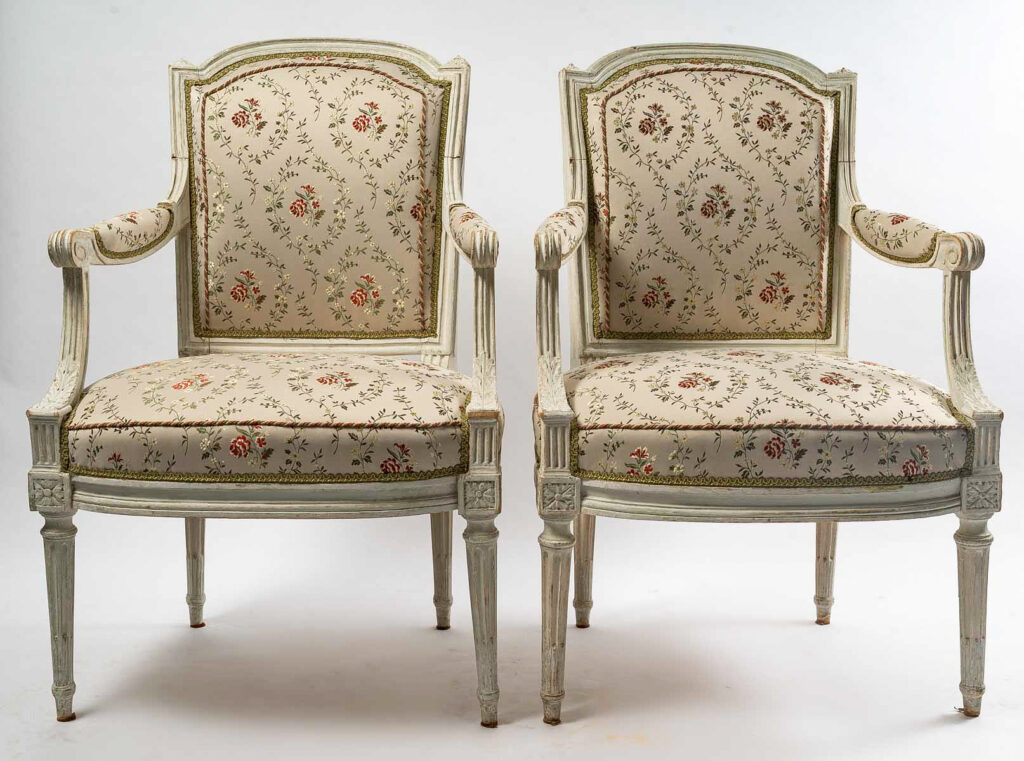Georges Jacob Pair of armchairs ordered in 1780 for the Grand Salon of Beauregard Castel
Circa 1780 the Marquis de Séréni commissioned Georges Jacob to design a set of seats in the Louis XVI style to furnish his castle, the Château de Beauregard in Burgundy.
A very similar set of seats was produced at the same period by Georges Jacob, our seats are to be compared with seats delivered for the Petit Trianon and kept today in Versailles, as well as armchairs present in the dining room of the Hôtel de la Marine Place de la Concorde.
Nos sièges qui faisaient partie du Salon commandé par le Marquis de Séréni, présentent l’estampille de Georges Jacob (très difficilement visible), la marque I.B du sculpteur, qui semble avoir aussi sculpté pour Jean-Baptiste Claude Séné. Enfin sur les sangles, les marques d’inventaire au pochoir SBGS, pour Marquis de Séréni – Château de Beauregard – Grand Salon.
The furniture of the Château de Beauregard was largely auctioned off at Christie's in 2008 and 2009.
Our armchairs are an authentic part of the history of French furniture produced in the 18th century.
A pair of armchairs in molded and carved beech wood, cream lacquered, the back slightly curved, the upper part in basket handle, the armrests with cuffs ending in scrolls and resting on fluted console uprights and decorated with acanthus leaves. The connecting piece is decorated with flowers. Feet tapered, fluted, and filleted.
Travail Français d’époque Louis XVI, vers 1780, les ceintures arrières estampillées G.Iacob pour la menuiserie et I.B pour la sculpture, les sangles portant des numéros d’inventaire B.S G.S
Dimensions fauteuils : Hauteur 90,5 cm – Largeur 59 cm – Profondeur d’assise 51 cm.
Our armchairs are in perfect condition, they have just been covered by a beautiful fabric with flowers in the taste of the seats kept in the dining room of the Hotel de la Marine in Paris.
Georges Jacob (1739-1814) - Master on September 4, 1765: He is the most famous and the most creative of all the cabinetmakers of the 18th century in France. His rich clientele included the royal family.
Georges Jacob was born in 1739 in Cheny in the Burgundy region. Son of Etienne Jacob and Françoise Beaujan, ploughmen.
He arrived in Paris at a very young age in 1755 as an apprentice carpenter with Jean-Baptiste Lerouge, established on rue de Charenton. He then joined Louis Delanois, the supplier of Madame du Barry, mistress of Louis XV, as a journeyman. The promoter of the neoclassical style in the seat, Delanois undoubtedly influenced Jacob's models.
Received master in 1765 thanks a small gilded wooden seat, Jacob then created his own workshop.
Two years later, he married Jeanne-Germaine Loyer from a family of master embroiderers.
Established in his first years on rue de Cléry, his workshops were moved in 1775 to rue Meslée where the most favorable period of his career took place and where the greatest royal orders were executed.
Georges Jacob is an innovator: it is also in the arrangement and decoration of the legs and arms of his seats that we find formulas launched if not imagined by him. Many of his chairs rest on tapered legs with rudentine flutes. These feet are connected to the belt by a die or case, decorated with a rose.




